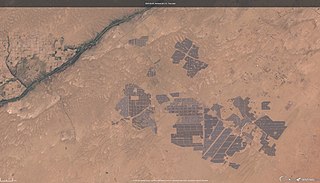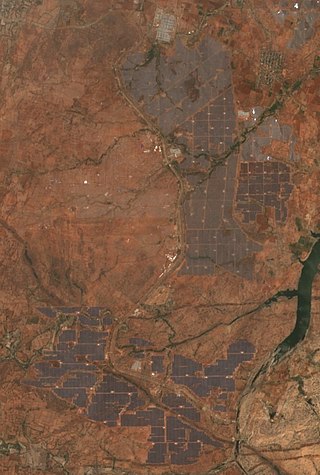
India is the third largest producer of electricity in the world. During the fiscal year (FY) 2022–23, the total electricity generation in the country was 1,844 TWh, of which 1,618 TWh was generated by utilities.

Many countries and territories have installed significant solar power capacity into their electrical grids to supplement or provide an alternative to conventional energy sources. Solar power plants use one of two technologies:
Patoda is a tehsil in Beed subdivision of Beed district, Maharashtra state, India.

India's solar power installed capacity was 73.32 GWAC as of 31 December 2023.

Solar power has a small role in electricity production in the United Kingdom.

China is the largest market in the world for both photovoltaics and solar thermal energy. China's photovoltaic industry began by making panels for satellites, and transitioned to the manufacture of domestic panels in the late 1990s. After substantial government incentives were introduced in 2011, China's solar power market grew dramatically: the country became the world's leading installer of photovoltaics in 2013. China surpassed Germany as the world's largest producer of photovoltaic energy in 2015, and became the first country to have over 100 GW of total installed photovoltaic capacity in 2017.

India is world's 4th largest consumer of electricity and world's 3rd largest renewable energy producer with 40% of energy capacity installed in the year 2022 coming from renewable sources. Ernst & Young's (EY) 2021 Renewable Energy Country Attractiveness Index (RECAI) ranked India 3rd behind USA and China. In FY2023-24, India is planning to issue 50 GW tenders for wind, solar and hybrid projects. India has committed for a goal of 500 GW renewable energy capacity by 2030. In line with this commitment, India's installed renewable energy capacity has been experiencing a steady upward trend. From 94.4 GW in 2021, the capacity has gone up to 119.1 GW in 2023 as of Q4.
The National Solar Mission is an initiative of the Government of India and State Governments to promote solar power. The mission is one of the several policies of the National Action Plan on Climate Change. The program was inaugurated as the Jawaharlal Nehru National Solar Mission by former Prime Minister Manmohan Singh on 11 January 2010 with a target of 20 GW by 2022. This was later increased to 100 GW by Prime Minister Narendra Modi in the 2015 Union budget of India. India increased its utility solar power generation capacity by nearly 5 times from 2,650 MW on 26 May 2014 to 12,288.83 MW on 31 March 2017. The country added 9,362.65 MW in 2017–18, the highest of any year. The original target of 20 GW was surpassed in 2018, four years ahead of the 2022 deadline.

Solar power in Gujarat, a state of India, is a fast developing industry given that the large state is mostly arid. It was one of the first states to develop solar generation capacity in India.

Power sector of Andhra Pradesh is divided into 4 categories namely Regulation, Generation, Transmission and Distribution. Andhra Pradesh Electricity Regulatory Commission (APERC) is the regulatory body. APGENCO deals with the electricity production and also maintenance, proposes new projects and upgrades existing ones as well. The APGENCO also set up a Special Purpose Vehicle (SPV), named as Andhra Pradesh Power Development Company Limited (APPDCL), a joint venture company of APGENCO and IL&FS to set up Krishnapatanam thermal power project.
ReNew Energy Global is a decarbonisation solutions company based in India. It is the first Indian renewable energy company to be listed on NASDAQ. ReNew operates more than 140 projects spread across nine states in India. The company provides decarbonisation solutions through a mix of green hydrogen, data-driven solutions, storage, manufacturing, and carbon markets.
Rewa Ultra Mega Solar is an operational ground mounted, grid-connected photovoltaic solar park spread over an area of 1,590 acres (6.4 km2) in the Gurh tehsil of Rewa district of Madhya Pradesh, India. It started producing power in 2018 and reached its full capacity of 750MW in January 2020. The project was dedicated to the nation by the Prime Minister of India Shri Narendra Modi on July 10, 2020. It was the first solar project in India to break the grid parity barrier. It achieved a first-year tariff of INR 2.97/unit, while the previous record was INR 4.34/unit.

Solar Energy Corporation of India Ltd. (SECI) is a company of the Ministry of New and Renewable Energy, Government of India, established to facilitate the implementation of the National Solar Mission (NSM). It is the only Central Public Sector Undertaking (PSU) dedicated to the solar energy sector. The company's mandate has been broadened to cover the entire renewable energy domain and the company will be renamed to Renewable Energy Corporation of India (RECI).

The Bhadla Solar Park is a solar power plant located in the Thar Desert of Rajasthan, India. It covers an area of 56 square kilometers and has a total installed capacity of 2’245 megawatts (MW), making it the largest solar park in the world as of 2023. The park was developed in four phases since 2015, with $775 million in funding from the Climate Investment Fund and $1.4 billion in funding from other sources. The park contributes to India's renewable energy goals and helps reduce greenhouse gas emissions by an estimated 4 million tons per year.

The NP Kunta Ultra Mega Solar Park, also known as Ananthapuram - I Ultra Mega Solar Park or Kadiri Ultra Mega Solar Park, is a solar park occupying a total area of 32 square kilometres (12 sq mi) in Nambulapulakunta mandal of Kadiri Constituency in Kadiri Division of Sri Sathya Sai district of the Indian state of Andhra Pradesh it is 35 km away from Kadiri.

Pavagada Solar Park is a solar park covering an area of 53 square kilometres in Pavagada taluk, Tumkur district, Karnataka. Completed in 2019, the park has a capacity of 2,050 MW. As of April 2021, it is the world's third largest photovoltaic solar park after the 2,245 MW Bhadla Solar Park in Rajasthan and 2,200 MW Huanghe Hydropower Hainan Solar Park in China. It is the second largest in India.The total project cost was ₹14,800 crore.

Kurnool Ultra Mega Solar Park in Andhra Pradesh is a solar park spread over a total area of 24 square kilometres (9.3 sq mi) in Panyam mandal of Kurnool district, Andhra Pradesh, with a capacity of 1000 MW. It was inaugurated by then chief minister of Andhra Pradesh Nara Chandrababu Naidu in 2019 The park was built at an investment of around ₹70 billion (US$880 million) by solar power developers and the Central and State governments. Solar power developers invested ₹10 billion (US$130 million), while the remaining ₹60 billion (US$750 million) was funded by APSPCL supported by a ₹2 billion (US$25 million) grant from the Union Government.
Kadapa Ultra Mega Solar Park is a solar park spread over a total area of 5,927.76 acres (23.9888 km2) in the Mylavaram mandal of Kadapa district, Andhra Pradesh.












